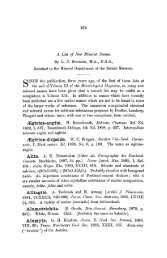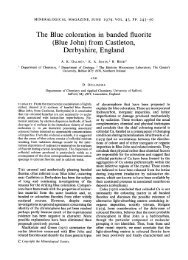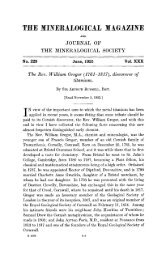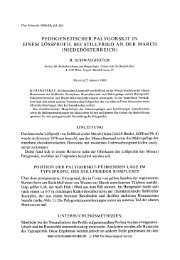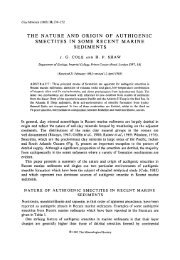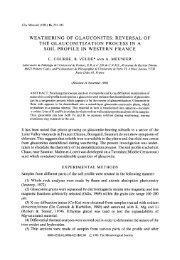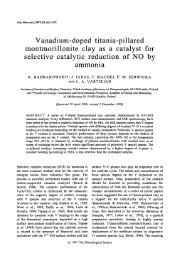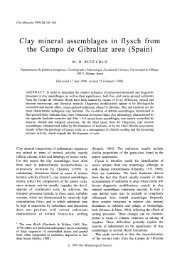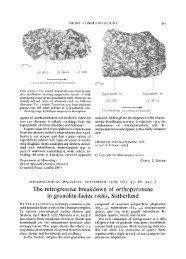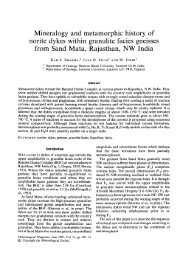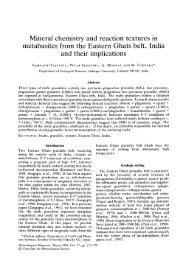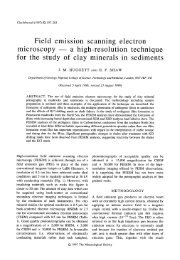Re-examination of the mineral tuhualite
Re-examination of the mineral tuhualite
Re-examination of the mineral tuhualite
You also want an ePaper? Increase the reach of your titles
YUMPU automatically turns print PDFs into web optimized ePapers that Google loves.
96<br />
<strong>Re</strong>-<strong>examination</strong> <strong>of</strong> <strong>the</strong> <strong>mineral</strong> <strong>tuhualite</strong><br />
By C. 0SBOR~E ]-~UTTON, M.Sc., Ph.D.<br />
Stanford University, Palo Alto, California, U.S.A.<br />
[Taken as read 3 November 1955.]<br />
Summary.--X-ray study <strong>of</strong> <strong>tuhualite</strong> from Mayor Island, New Zealand, has<br />
shown it to be orthorhombic, space-group ei<strong>the</strong>r Cmca -- D.~Sa or C2ca = C~ 7.<br />
Unit-cell dimensions are a = 14.31., b = 17.28A., c -- 10.11A., and a :b :c =<br />
0.828 : 1 : 0-585. Goniometric measurements give a : b : c 0.8243 : 1 : 0-5658.<br />
a(100} dominant with forms s(011}, p(021}, c{001}, b{010}, n(101}, m(ll0}, q{111}.<br />
Crystals with b(010} dominant are rare. Three good cleavages, a (100), b (010),<br />
c (001). a = 1.608, fl = 1.612, 7 = 1.621; 7--~ 0.013. 2V = 61~-70~, positive;<br />
fl ~ b, 7 ~ c, a = colourless to pale lavender, fi = violet, lavender, 7 = intense<br />
purplish-blue; 7 :> fl > a. Sp. gr. 2'89 (measured), 2,86 (calculated).<br />
An analysis <strong>of</strong> carefully purified material leads to <strong>the</strong> possible formula:<br />
Hg(Na,K,Mnh2Fe~'(A1,Fe",Mg,Ti)9[Si808115.<br />
Details <strong>of</strong> alteration phenomena and associated <strong>mineral</strong>s are given. Occurrence<br />
is held to result by crystallization from magma quite impoverished in lime due to<br />
early fractionation <strong>of</strong> aegirine-hedenbergite, and perhaps aegirine-augite, in <strong>the</strong><br />
intratelluric stage.<br />
T<br />
UHUALITE is a constituent <strong>of</strong> ejectamenta on Mayor Island, New<br />
Zealand, at and in <strong>the</strong> vicinity <strong>of</strong> Opo Bay at <strong>the</strong> sou<strong>the</strong>rn extremity<br />
<strong>of</strong> <strong>the</strong> island, and occurs in situ in banded rhyolites that outcrop along <strong>the</strong><br />
base <strong>of</strong> <strong>the</strong> caldera wall just north-cast <strong>of</strong> Tutaretare (1162 feet). Mayor<br />
Island, <strong>the</strong> Maori name for which is Tuhua, lies in latitude 37 ~ 20' South<br />
and longitude 176 ~ 15' East, within <strong>the</strong> Bay <strong>of</strong> Plenty <strong>of</strong>[ <strong>the</strong> east<br />
coast <strong>of</strong> North Island, New Zealand. The island is a volcanic cone with<br />
an elevation <strong>of</strong> 1274 feet above sea-level. The rocks are acidic in charac-<br />
ter and consist <strong>of</strong> a series <strong>of</strong> lavas, <strong>of</strong>ten pure obsidians, and tufts, and<br />
most if not all <strong>of</strong> <strong>the</strong>se have comenditic affinities.<br />
The first record <strong>of</strong> <strong>the</strong> paragenesis and properties <strong>of</strong> <strong>tuhualite</strong> is found<br />
in a preliminary account <strong>of</strong> some volcanic rocks from North Island, New<br />
Zealand, by Marshall (1932, p. 202). In that paper attention was called<br />
to <strong>the</strong> presence in comendites on Mayor Island <strong>of</strong> 'a supposedly new<br />
amphibole with <strong>the</strong> extraordinary pleochroism, colorless to purplish<br />
violet to deep violet', in association with <strong>the</strong> sodic ferromagnesian con-<br />
stituents aegirine, cossyrite, and arfvedsonite; <strong>the</strong> last <strong>mineral</strong> was<br />
subsequently shown to be riebeckite (Marshall, 1936A, p. 341).<br />
Later, Marshall (1936B) published a more detailed paper on <strong>tuhualite</strong>.<br />
Crystallographic measurements that were secured with <strong>the</strong> aid <strong>of</strong> a stage
TUHUALITE 97<br />
goniometer are reported and <strong>the</strong>se data led to <strong>the</strong> belief that <strong>the</strong> <strong>mineral</strong><br />
was orthorhombic with a: b: c ~ 0.915:1 : 0-512. On <strong>the</strong> basis <strong>of</strong> <strong>the</strong>se<br />
data Marshall came to <strong>the</strong> conclusion that his previous opinion that <strong>the</strong><br />
<strong>mineral</strong> was an amphibole was an incorrect one. Some optical data,<br />
determined by o<strong>the</strong>r workers, are reported, and finally Marshall listed<br />
four analyses <strong>of</strong> comendites made by Mr. F. T. Seelye, one supposedly<br />
devoid <strong>of</strong> <strong>tuhualite</strong>, which in <strong>the</strong> present writer's opinion do not differ<br />
in any significant degree from one ano<strong>the</strong>r. However, on <strong>the</strong> basis <strong>of</strong><br />
<strong>the</strong> supposed differences between <strong>the</strong>se analyses Marshall calculated a<br />
composition for <strong>tuhualite</strong> itself (table III, anal. B).<br />
The petrography <strong>of</strong> <strong>the</strong> Mayor Island sodic rhyolites had been in-<br />
vestigated previously; yon Wolff (1904) described material donated by<br />
Thileniu8, and J. A. Bartrum (1926) carefully studied specimens collected<br />
by J. A. Thomson during <strong>the</strong> latter's visit to <strong>the</strong> island in 1920, and also<br />
some thin sections lent to him by Speight. Marshall visited <strong>the</strong> island<br />
on at least two occasions and collected <strong>the</strong> material that formed <strong>the</strong><br />
basis <strong>of</strong> three papers (Marshall, 1932, 1936A, 1936B).<br />
The new analysis and <strong>the</strong> crystallographic and X-ray studies <strong>of</strong><br />
<strong>tuhualite</strong> reported on herein were made with material obtained from<br />
specimens collected by Marshall himself, and some incidental observa-<br />
tions on <strong>mineral</strong> association were made with material collected by o<strong>the</strong>rs.<br />
A few crystal measurements were also performed on material given to<br />
<strong>the</strong> writer byDr. P. G. Harris, who had in <strong>the</strong> first place obtained it from<br />
Marshall.<br />
Occurrence <strong>of</strong> <strong>tuhualite</strong>.<br />
In <strong>the</strong> material examined by this writer <strong>tuhualite</strong> has been found to<br />
occur as follows: (a) As a constituent <strong>of</strong> crudely microsl)herulitie<br />
aggregates <strong>of</strong> felspar, quartz, aenigmatite, riebeckite, and c~girine in<br />
<strong>the</strong> groundmass <strong>of</strong> both non-porphyritic and coarsely porphyritic<br />
comendites; and <strong>the</strong>re appears to be every gradation between this<br />
association and microstructure and that in which <strong>tuhualite</strong> in irregular,<br />
moss-like outline, almost pigmentary in form, is intimately associated<br />
with alkali-felspar, quartz~ and any one or combination <strong>of</strong> <strong>the</strong> sodic<br />
ferromagnesian constituents on a microerystalline scale with or without<br />
marked flow structures. In a nmnber <strong>of</strong> instances <strong>tuhualite</strong> is sufficiently<br />
abundant to produce deep blue areas that are quite obvious mega-<br />
scopically. However, it should be pointed out that <strong>the</strong> percentage <strong>of</strong><br />
<strong>tuhualite</strong> in <strong>the</strong>se areas is low and in no case has <strong>the</strong> present writer found<br />
it to make up 50 % <strong>of</strong> such areas (el. Marshall, 1936~, p. 335). (.b) More<br />
B 5381 H
98 c.o. ~UTTON ON<br />
or less equidimensional subeuhedral isolated crystals up to 0-25 mm. in<br />
diameter, which are <strong>of</strong>ten situated in portions <strong>of</strong> <strong>the</strong> rock somewhat more<br />
coarsely crystalline than <strong>the</strong> average. (c) As euhedra (1-5 ram. in length)<br />
in very porous, pale grey zones in comendite, and in steam cavities<br />
where <strong>the</strong> best euhedra have been noted ; <strong>the</strong>se may occur alone or with<br />
ei<strong>the</strong>r stout euhedra <strong>of</strong> aegirine or fiat prismatic crystals <strong>of</strong> riebeckite, or<br />
both.<br />
In many <strong>of</strong> <strong>the</strong> rhyolites examined, most <strong>of</strong> which were devoid <strong>of</strong><br />
<strong>tuhualite</strong>, a pale greenish-yellow to orange-yellow <strong>mineral</strong> <strong>of</strong> serpentinous<br />
appearance was recognized ; it is especially well developed in <strong>the</strong> dark-<br />
coloured, finely banded rocks from <strong>the</strong> crater area and gives rise to <strong>the</strong><br />
narrow yellow bands <strong>the</strong>rein as seen in hand specimens. For it <strong>the</strong> follow-<br />
ing properties have been determined: ?-~ < 0.010; n = 1"547-1.551;<br />
pleochroism not recognizable.<br />
A second, but uncommon, yellow <strong>mineral</strong> <strong>of</strong> irregular outline occurs<br />
in <strong>the</strong> <strong>tuhualite</strong>-bearing comendites, and this may be <strong>the</strong> material com-<br />
mented upon by Marshall (1936B, p. 336), although it is quite uncertain<br />
whe<strong>the</strong>r Marshall was referring to this or to <strong>the</strong> more abundantly<br />
developed yellow serpentinous material just mentioned. It has <strong>the</strong><br />
following optical properties: a = 1"603~:0.003, fl = 1.613, ~- 1.620,<br />
V--~ = 0"017. Optic axial angle measurements gave: 82 ~ (-), 66 ~ (--);<br />
for a strongly zoned crystal : inner zone = 64 ~ (-), outer zone = 72 ~ (-).<br />
Dispersion is strong in most fragments with p < v, although this is<br />
absent in a few instances. Pleochroism is faint, with a = pale yellowish-<br />
green, ~, = pale yellow ; ? ~ a. At least one good cleavage is evident<br />
with extinction oblique <strong>the</strong>reto. In <strong>the</strong> yellow <strong>mineral</strong> noted by Marshall<br />
lamellar twinning appeared to be common; this property was not ob-<br />
served in any <strong>of</strong> <strong>the</strong> examples studied at this time.<br />
The similarity <strong>of</strong> <strong>the</strong> refractive indices <strong>of</strong> this <strong>mineral</strong> to those <strong>of</strong><br />
<strong>tuhualite</strong> is interesting, especially so since instances have been found<br />
occasionally where crystals exhibit gradations from <strong>tuhualite</strong>-like<br />
material outwards into <strong>the</strong> clear yellow <strong>mineral</strong> <strong>of</strong> unknown composition, i<br />
Physical properties.<br />
Tuhualite is excessively brittle, so much so that any attempt to release<br />
a crystal from attachment to a vesicle wall causes severe fracturing <strong>of</strong><br />
<strong>the</strong> crystal. Accordingly <strong>the</strong> fragments used for X-ray and o<strong>the</strong>r work<br />
1 A very faint X-ray diffraction pattern obtained from a minute amount <strong>of</strong> this<br />
<strong>mineral</strong> exhibited two lines at d -- 3.45 z~. and 3-35 ~. in order <strong>of</strong> decreasing<br />
intensity.
TUHUALITE 99<br />
never exceeded 0-25 nun. Three good pinacoidal cleavages are present,<br />
but that perpendicular to <strong>the</strong> vertical crystallographic axis, <strong>the</strong> acute<br />
bisectrix, appears to be superior to <strong>the</strong> o<strong>the</strong>r two.<br />
It was found that most <strong>of</strong> <strong>the</strong> crystal fragments were contaminated<br />
by adhering quartz or felspar, or both, and <strong>the</strong>refore specific gravity<br />
determinations were made by repeatedly centrifuging <strong>the</strong> pure <strong>mineral</strong><br />
powder obtained for analysis in methylene iodide-brom<strong>of</strong>orm-acetone<br />
mixtures; a value <strong>of</strong> 2"89d:0"02, corrected for determination made at<br />
20 ~ C., was obtained, and this corresponds closely with values secured<br />
from seven fragments whose purity could not be absolutely guaranteed,<br />
2"88:s Hardness, determined with a fine needle point on <strong>the</strong> sur-<br />
faces <strong>of</strong> a crystal cemented to a glass slide, is about 3 to 4.<br />
<strong>Re</strong>fractive indices and pleochroism for <strong>tuhualite</strong> as analysed were<br />
found to be: a = 1-608&0.001, fl = 1.612, 7 = 1.621-4-0.003, $--a =<br />
0"013 ; a = colourless to very pale pink, fi = violet or lavender, 1t = in-<br />
tense purplish-blue ; ~ > fl > a, with much less difference between fl and<br />
7 than between fl and ~.<br />
The limits <strong>of</strong> error are much wider in <strong>the</strong> case <strong>of</strong> <strong>the</strong> y-vibration<br />
direction <strong>of</strong> <strong>the</strong> refractive index ellipsoid owing to intense absorption,<br />
even in fragments less than 20 microns in thickness. <strong>Re</strong>fractive indices<br />
for <strong>the</strong> a-vibration direction in a number <strong>of</strong> crystal fragments not in-<br />
cluded in <strong>the</strong> analysed material were: 1-604,1-609, and 1.606. These values<br />
possibly indicate a range <strong>of</strong> chemical composition from grain to grain,<br />
and zoning was clearly observed during measurement <strong>of</strong> 2V, although<br />
colour and pleochroism did not seem to be correspondingly affected.<br />
The values obtained for <strong>the</strong> analysed material reported on in thi~<br />
paper differ appreciably from those determined for a crystal <strong>of</strong> tuhuahte<br />
by <strong>the</strong> present writer in 1935 at <strong>the</strong> request <strong>of</strong> MarshM]. The reason for<br />
this discrepancy is not clear at this stage.<br />
The <strong>mineral</strong> is optically positive, and optic axiM-angle measurements<br />
made in monochromatic light <strong>of</strong> wavelengths 4900 X. and 6026 X.<br />
(values for <strong>the</strong> latter in paren<strong>the</strong>ses) gave a distinct range <strong>of</strong> values as<br />
follows: analysed material 70 ~ (61 ~176 crushed crystal fragments 76 ~ ,<br />
78 ~ 76 ~ (70 ~ 72 ~ 69~ a zoned crystal gave 76 ~ (68 ~ for centre, 80 ~<br />
(70 ~ for median zone, and 91 ~ (82 ~ for a narrow peripheral zone. Disper-<br />
sion <strong>of</strong> <strong>the</strong> optic axes is strong with p < v, and <strong>the</strong> optic axial plane is<br />
parallel to (010), that is, fi = b. Elongation positive, ? ---- c.<br />
As distinct from gradation <strong>of</strong> <strong>tuhualite</strong> into <strong>the</strong> yellow <strong>mineral</strong> <strong>of</strong><br />
undetermined composition, clearly a magmatic reaction, <strong>tuhualite</strong> has<br />
undergone changes due to wea<strong>the</strong>ring. There is no doubt that <strong>the</strong> end-
I00 C.O. HUTTON ON<br />
products are red-brown patches <strong>of</strong> limonitic iron oxides, but intermediate<br />
stages are less clear. Early in <strong>the</strong> breakdown, however, a slight loss <strong>of</strong><br />
colour with almost complete loss <strong>of</strong> pleoohroism and diminution in bire-<br />
fringence takes place, and in <strong>the</strong> few instances observed such crystals<br />
were optically negative (change <strong>of</strong> sign) with 2V close to 30 ~ A later<br />
a !b b<br />
m 7"<br />
Fro. ]. Crystals <strong>of</strong> tuhuMite from Mayor Island. A, common tmbit ; ~, rare habit.<br />
stage involves development <strong>of</strong> isotropy and appearance <strong>of</strong> iron stain,<br />
although moderate absorption in lavender remains. Rare crystal frag-<br />
ments, colourless but o<strong>the</strong>rwise comparable to <strong>tuhualite</strong>, have been<br />
recognized; to what stage in <strong>the</strong> decomposition process such fragments<br />
belong, if <strong>the</strong>y do, is unknown.<br />
When <strong>the</strong> Gladstone and Dale formula (n--1)/D = K is applied<br />
to <strong>tuhualite</strong> <strong>the</strong> value <strong>of</strong> K, 0-2154, derived from <strong>the</strong> physical con-<br />
stants, approximates fairly closely to that obtained from <strong>the</strong> composition<br />
(0"2183) ; <strong>the</strong>se values are comparable to those found for close-packed<br />
structures.<br />
Morphology.<br />
Examination <strong>of</strong> crystals that were carefully removed from steam<br />
cavities shows that <strong>the</strong> form a{100} is usually dominant with s{011},<br />
p{021}, c{001}, and b{010} about equally developed (fig. 1A). m{ll0} and<br />
n{101} are slightly less well developed in <strong>the</strong> crystal figured (fig. h);
TUHUALITE 101<br />
on <strong>the</strong> o<strong>the</strong>r hand, a few stumpy crystals were found to exhibit about<br />
equal development <strong>of</strong> <strong>the</strong> forms a(100}, b(010}, m(ll0}, with c(001}, n(101},<br />
and s(011} as <strong>the</strong> only terminal forms. Rarely crystals were noted with<br />
b(010} dominant, a(100}, c(00]}, and s(011} as sole forms (fig. 1B).<br />
q{lll} appears to be uncommon.<br />
No crystals were found suitable for accurate goniometric treatment<br />
owing to small size and to curvature or irregularity <strong>of</strong> faces. However,<br />
approximate measurements were made, in some instances with <strong>the</strong><br />
Fedorov stage and stage micrometer, and <strong>the</strong>se data are compared with<br />
Marshall's values and <strong>the</strong> angles calculated from <strong>the</strong> structural cell in<br />
table I. Since <strong>the</strong> X-ray data were secured from a greater number <strong>of</strong><br />
measurements more weight should be attached to <strong>the</strong> values in column C<br />
<strong>of</strong> table I.<br />
TABLE I. Angle table for <strong>tuhualite</strong>: A, based on goniometric measurements (zone<br />
adjusted, [001] ; b (010) at r 0 ~ compared with B, angles based on <strong>the</strong> measure-<br />
ments <strong>of</strong> Marshall (1936B), and C, angles calculated from <strong>the</strong> X-ray data. Marshall<br />
also cites aq 52.0 ~ (cult. 58 ~ 39').<br />
A. B. C.<br />
r p. r p. r p.<br />
n (101) 90 ~ 00' 34 + 30' -- -- 90 ~ 00' 35 ~ 15'<br />
s (011) 0 ~ 00' 29 ~ 30' 0 ~ 00" 27 ~ 24' 0 ~ 00' 30 ~ 22'<br />
p (021) 0 ~ 00' 48 ~ 00' 0 ~ 00' 50 ~ 24' 0 ~ 00' 49 ~ 29'<br />
m (110) 50 ~ 30' 90 ~ 00' 47 ~ 42' 90 ~ 00' 50 ~ 18' 90 ~ 00"<br />
q (111) 50 ~ 30' 42 ~ 00' -- -- 50 ~ 18' 42 ~ 33'<br />
X-ray study.<br />
A camera <strong>of</strong> diameter 114.59 ram. and manganese-filtered iron-radia-<br />
tion, Fe-Ka = 1"9373 A., were used to obtain powder photographs <strong>of</strong><br />
<strong>tuhualite</strong> as analysed. Many <strong>of</strong> <strong>the</strong> reflections, however, are weak and<br />
diffuse, particularly in <strong>the</strong> region <strong>of</strong> high 20 values, and <strong>the</strong>refore it was<br />
not possible to measure <strong>the</strong> latter with acceptable accuracy. The X-ray<br />
powder data are set out in table II toge<strong>the</strong>r with indices and spacings<br />
that have been calculated from <strong>the</strong> lattice dimensions secured from<br />
rotation and Weissenberg photographs, obtained with <strong>the</strong> crystal frag-<br />
ment figured (fig. ]A): a = 14"31 X., b = 17"28 ~.,<br />
c = 10.11 ~. Cell volume = 2499"96 ~.a, and with <strong>the</strong> sp. gr.<br />
a cell weight <strong>of</strong> 7224.88 10 -24 g. is found.<br />
This leads to an axial ratio <strong>of</strong> a : b : c <strong>of</strong> 0-828 : 1 : 0"585. Calculation <strong>of</strong><br />
<strong>the</strong> density from <strong>the</strong> relation D = 1-66030 ~ A/V and employing <strong>the</strong><br />
formulary quantities in column D <strong>of</strong> table IV gave 2.86, a figure that is<br />
slightly less than that determined experimentally.
102 C.o. HUTTO~r ON<br />
Systematic indexing <strong>of</strong> <strong>the</strong> Weissenberg patterns indicated that <strong>the</strong><br />
space-group is ei<strong>the</strong>r Cmca = D~a s or C2ca = C~v .<br />
TabLE II. Powder pattern <strong>of</strong> <strong>tuhualite</strong>, Opo Bay, Mayor Island ; Fe-Ka radiation<br />
with ~ 1.9373 ~. Camera diameter 114.59 ram. Intensities estimated visually.<br />
~kl. d (obs.)<br />
020 8-62 8-62 s<br />
200 7.16 (A) 7.16 vs<br />
220 5.515 5.515 s<br />
130 5-34 5"34 vvw<br />
002 5.04 5-05 w<br />
221 4"85 4"85 s<br />
310 4.57 4-60 vw<br />
022 4"35 4"36 s<br />
040 4-315 4"32 s<br />
202 4"115 4.12 vw<br />
041 3"96 3"97 w<br />
222 ]3"72<br />
240 3"71 [3"70 s<br />
330 /3"67<br />
132 3'67 (3"67 m<br />
400 3-58 3"58 m<br />
241 /3.475<br />
331 3"47 [3"455 s<br />
420 3"31 3"305 m<br />
042 3-285 3"285 m<br />
113 3.22 3'22 m<br />
151 3"18 (C) 3"19 s<br />
421 3.14 3"145 m<br />
242 2.97 2"984 m<br />
402 2.926 2"921 w<br />
060 2.87 / 2'88<br />
133 (2.851 vw<br />
061 2.766 (B) / 2"77<br />
422 (2"766 s<br />
440 2.75 2-755 vvw<br />
441 2-657 [2"659<br />
043 [2.658 m<br />
And numerous o<strong>the</strong>r lines<br />
desirable accuracy.<br />
d (tale.) I. hkt. d (obs.) d (calo.) I.<br />
004 2.522 ~2.528<br />
062 [2.52 vw<br />
531 2.490 2"485 m<br />
442 2.416 2.42 w<br />
204 2.378 [2.382<br />
153 (2"379 vvw<br />
171 2-362 / 2"366<br />
423 (2.36 vw<br />
461 2.184 2-19 s<br />
353 2.147 2.153 vw<br />
-- 2"078 -- vvw<br />
-- 2"053 -- vvw<br />
- - 2.002 -- w<br />
-- 1.974 -- w<br />
-- 1"937 -- vvw<br />
-- 1"887 -- vvw<br />
-- 1"86 -- vw<br />
- - 1"839 -- vw<br />
-- 1.789 -- w<br />
-- 1"767 -- vvw<br />
-- 1"726 -- s<br />
-- 1.669 -- vvw<br />
-- 1"653 -- vvw<br />
-- 1"550 -- vw<br />
-- 1"535 -- vw<br />
-- 1"501 -- vvw<br />
- - 1"483 -- vw<br />
-- 1.452 -- w<br />
at greater 28 values that could not be measured with<br />
A, B, and C: Most prominent lines, decreasing in intensity in order A to C.<br />
Chemical composition.<br />
A large sample <strong>of</strong> comendite, approximately 820 g. in weight, was<br />
broken down to ~ 30 micron particle size by crushing, screening, and<br />
elutriation. The total bulk <strong>of</strong> this material was <strong>the</strong>n centrifuged in a<br />
brom<strong>of</strong>orm-acetone mixture <strong>of</strong> density 2-70, and from <strong>the</strong> heavy fraction<br />
so obtained an apparently pure sample <strong>of</strong> <strong>tuhualite</strong> weighing 0.92 g.<br />
was secured by repeated centrifugal fractionation. As purification <strong>of</strong> <strong>the</strong>
TUHUALITE 103<br />
sample proceeded, fine-grinding carefully performed under alcohol was<br />
required in order to free <strong>tuhualite</strong> particles from contaminating quartz,<br />
felspar, riebeckite, &c. The separation was carried out approximately<br />
quantitatively, and <strong>the</strong> small quantity recovered gives a good indication<br />
<strong>of</strong> <strong>the</strong> percentage <strong>of</strong> <strong>tuhualite</strong> in <strong>the</strong> rock in spite <strong>of</strong> <strong>the</strong> fact that <strong>the</strong><br />
original sample exhibited many deep-blue patches. It will be recalled<br />
that Marshall (1936B, p. 335) expressed <strong>the</strong> opinion that <strong>the</strong> blue patches<br />
contained approximately 50 % <strong>of</strong> <strong>tuhualite</strong>.<br />
Scarcity <strong>of</strong> material did not permit any chemical tests beyond those<br />
that indicated that <strong>tuhualite</strong> is not noticeably affected by ei<strong>the</strong>r hot con-<br />
centrated HC1 or H2S0 4 after five minutes <strong>of</strong> such treatment. Analyses<br />
<strong>of</strong> comendite and <strong>tuhualite</strong> are set out in table III, and analysis C <strong>of</strong><br />
TABLE III. Analyses <strong>of</strong>comendite and <strong>tuhualite</strong> from Opo Bay,<br />
Mayor Island, New Zealand.<br />
A. B. C.<br />
Si02 ... 72-28 75.36 62.93<br />
A12Os ... 9.75 9.33 0.63<br />
F%0a ... 4.44 3.61 14.09<br />
FeO ... 1.43 2.33 9.58<br />
MgO ... 0.28 0.06 0.42<br />
CaO ... 0.44 0.25 tr. ?<br />
Na~0 ... 4-96 4.75 7.11<br />
K~O ... 4.50 4.06 1.74<br />
H~0- ... 1.04 0.21(--) 0.38<br />
tt~0 + ... 0-68 0.12(--) 1.61<br />
Ti02 ... 0.23 0.23 0.42<br />
P205 ... 0.04 -- nil<br />
MnO ... 0.14 0.18 0.81<br />
100.44 100.16 99.72<br />
0 for F ... 0.03<br />
100,41<br />
A. Comendite, Mayor Island. Anal. F. T. Seelye (Marshall, 1936A, p. 343). Also<br />
S 0-02, Zr02 0'03, rare earths 0.10, C1 0.02, F 0.06 %. B20 a, Ni0, BaO, SrO,<br />
and C02 0.00 %.<br />
B. Marshall's analysis <strong>of</strong> r arrived at by calculation (Marshall, 1936B, p.<br />
335). Negative values for water are neglected in summation.<br />
C. Tuhualite, Mayor Island. Anal. C. Osborne Hutton.<br />
this table has been recalculated to determine <strong>the</strong> number <strong>of</strong> atoms <strong>of</strong><br />
each kind in <strong>the</strong> empirical unit-cell (table IV), with full consideration<br />
given to <strong>the</strong> probable errors incurred in <strong>the</strong> physical measurements and<br />
chemical analysis.<br />
On <strong>the</strong> basis <strong>of</strong> <strong>the</strong> calculations summarized in table IV, <strong>the</strong> actual<br />
numbers <strong>of</strong> (0,0H) atoms in <strong>the</strong> unit-cell lie between 119.90 and 122-42,
104 C.O. HUTTON ON<br />
TABLE IV. Empirical unit-cell contents <strong>of</strong> <strong>tuhualite</strong> with probable errors based on<br />
<strong>the</strong> assessed errors <strong>of</strong> <strong>the</strong> chemical analysis and <strong>the</strong> physical data.<br />
A. B. C. D. E.<br />
Si02 ...... 62-93 i- 0.20 Si 45.89 :_0-46 45.45 0-43<br />
AI20 s ...... 0.63= 0-30 A1 0.53 :-0.2(l 0.53 0-50<br />
Fe203 ...... 14-09 "0.40 Fe" 7-72-! 0.23 7.65 0-60<br />
MgO ...... 0.42-L0-10 Mg 0.44 0.11 0-45 0-65<br />
TiOz ...... t).42 :_0.04 Ti 0-22 0-22 0-68<br />
FeO ...... 9.582.0.30 Fe" 5-83!_0.18 5.78 0-75<br />
5{nO ...... I).81 ~-0-02 Mn 0.49 ::- 0.01 0.49 0-80<br />
Na20 ...... 7.11 _!-0-20 Na 10.04.= 0.30 9"95 0.95<br />
K~O ...... 1.74 r0-o6 K 1.61 a ().05 1.59 1.33<br />
HzO ...... 1.61 -k0.25 (OH) 7.83_t_1-22 7.75 -<br />
~iala = 0.00209; Bblb 0.00173; g:,clc : 0.00296; BDID 0.00692.<br />
D (corrected) -= 2.8(.t.'0.02.<br />
Conversion factor F = (abeD)l(1.6603 99.34) = 43.804.<br />
Cell volume , 2499.96,~.3<br />
Cell weight :: 7224.88 l0 2,t g.<br />
o.~ oxygen in <strong>tuhualite</strong> 121.16 16IF = 44-25 o~.<br />
Error due to <strong>the</strong> FeO determination (F~P/2m) : 0-091.<br />
Total error in Z (O,OH) : 1.26.<br />
Total error in 0 = 1.21.<br />
Z (A1,Fe",Mg,Ti) - 8-99:r0'37.<br />
Z (Mn,Na,K) = 12.14.i-0.33.<br />
E (O,OH) = 121.16--1-26.<br />
Total iron as FeA) z : 24.74-: 0.25.<br />
Possible formub~ <strong>of</strong> <strong>tuhualite</strong>: llg(Na,K,l~n)~2Fe~(A1,Fe',Mg,Ti)s[SiaOs]t~.<br />
i.<br />
B.<br />
C.<br />
D.<br />
E.<br />
Weight o//o <strong>of</strong> oxides (: P).<br />
Empirical unit-cell contents, YPm/M (Min. Mag., 1954, vol. 30, p. 481).<br />
gE :-- assessed probable errors due to $cE (derived from <strong>the</strong> chemical analysis)<br />
and SpE (derived from <strong>the</strong> physical data).<br />
Number <strong>of</strong> atoms on <strong>the</strong> basis <strong>of</strong> 120 (O,OH) atoms to <strong>the</strong> unit-cell.<br />
Ionic radii according to Pauling.<br />
and accordingly 120 is suggested as a probable figure in this instance.<br />
Fur<strong>the</strong>r, <strong>the</strong> integers 9, 6, and 12 are clearly within <strong>the</strong> limits <strong>of</strong> error for<br />
<strong>the</strong> Fe", Fe", and Na groups. It might be pointed out that inclusion <strong>of</strong><br />
Mg with <strong>the</strong> Fe" group ra<strong>the</strong>r than with Fe" is more appropriate in view<br />
<strong>of</strong> <strong>the</strong> values <strong>of</strong> <strong>the</strong> ionic radii concerned. The amount by which Si departs<br />
from <strong>the</strong> integral v~iue <strong>of</strong> 45 suggests possible quartz impurity ia <strong>the</strong><br />
analysed material, but if this is <strong>the</strong> answer, <strong>the</strong> weight ~ <strong>of</strong> quartz con-<br />
taminant wouht not appear to exceed 0-6.<br />
Accordingly it is suggested that <strong>the</strong> empirical unit-cell contents <strong>of</strong><br />
<strong>tuhualite</strong> may be represented by <strong>the</strong> formula:<br />
II9(Na,K,Mn)~2Fe~(AI,Fe",Mg,Ti)9(SiaOs)I a.
TUI[L'ALITE 105<br />
Petrogenesis.<br />
Comenditcs and pantellerites are well developed in widely scattered<br />
localities Sardinia, Pantelleria, Queensland, New South Wales, and<br />
British East Africa, to mention a few and <strong>the</strong>y have been closely<br />
studied. But in nolle <strong>of</strong> <strong>the</strong>se occurrences has <strong>tuhualite</strong> been observed<br />
in <strong>the</strong> acid lavas, and since its optical properties are so distinctive it is<br />
unlikely that it could have been overlooked. Accordingly, <strong>the</strong> unique<br />
occurrence <strong>of</strong> <strong>tuhualite</strong> in Mayor Island rocks is doubly interesting since<br />
<strong>the</strong> composition <strong>of</strong> <strong>the</strong>se rocks (table III, analysis A) does not (lifter in<br />
any significant detail from many described from Sardinia, Pantellcria,<br />
and East Africa. One is <strong>the</strong>refore tempted to conclude that critical con-<br />
ditions <strong>of</strong> temperature and pressure ra<strong>the</strong>r than unique composition<br />
<strong>of</strong> magma might be <strong>the</strong> important factor in permitting crystallization<br />
<strong>of</strong> this <strong>mineral</strong>.<br />
Study <strong>of</strong> numerous specimens shows that <strong>tuhualite</strong> has crystallized<br />
ei<strong>the</strong>r in association with quartz and felspar in <strong>the</strong> groundmass, or at<br />
<strong>the</strong> latest stage, <strong>of</strong>ten accompanied by riebeckite and aegirine, in vesicles,<br />
and <strong>the</strong> t)resent study has not shown it to be a member <strong>of</strong> <strong>the</strong> intra-<br />
telluric <strong>mineral</strong> assemblage which includes quartz, sanidine, sodic<br />
pyroxene, and aenigmatite.<br />
Incomplete study shows that <strong>the</strong> phenocrystic pyroxene is <strong>of</strong>ten<br />
strongly zoned, with wider extinction angles than those usually recog-<br />
nized for aegirine. Jr'or several phenocrysts <strong>the</strong> following properties were<br />
found: ~ ~Ac = 25 ~ 2V~ 72 ~ (~-); aAc = 23 ~ 2V = 88~ p ~v<br />
strong; a Ac ~: 12 ~ 7 = 1.785. A marked decrease in extinction angle<br />
was evident in some peripheral zones. These data suggest that much <strong>of</strong><br />
<strong>the</strong> phenocrystic pyroxene is aegirine-hedenbergite ra<strong>the</strong>r than aegirine<br />
in composition, with perhaps diopside also entering into <strong>the</strong> composition.<br />
For crystals separated from vesicles much smaller extinction angles were<br />
generally rei)resented , and <strong>the</strong> following data appeared to be typical:<br />
= 1.758, 7 ~ 1.810, ~ Ac = 0 to 2 ~ ; dispersion not strong. Incomplete<br />
as <strong>the</strong>se data are it would seem as if <strong>the</strong> vesicle crystals arc elos~r to<br />
aegirine in composition than is <strong>the</strong> phenocrystic material.<br />
Therefore it is suggested that early separation <strong>of</strong> hedenbergitic or<br />
diopsidie aegirine in <strong>the</strong> form <strong>of</strong> phenocrysts has more or less exhausted<br />
<strong>the</strong> originally small supply <strong>of</strong> lime, but not <strong>of</strong> alkalis and iron, in<br />
<strong>the</strong> magma; this has resulted, at a later stage, in crystallization <strong>of</strong><br />
1 Fedorov stage determinations employing hemispheres <strong>of</strong> n : 1.649; angles <strong>of</strong><br />
tilt were corrected.
106 c.o. HUTTON O51 TUHUALITE<br />
aegirine, 1 with presumably negligible calcium content , and <strong>tuhualite</strong><br />
devoid <strong>of</strong> that element. Accordingly an appeal to special pressure-<br />
temperature conditions would seem to be unnecessary.<br />
Ackn~wledgements.--It is a pleasure to express great appreciation <strong>of</strong> <strong>the</strong> assis-<br />
tance <strong>of</strong> Dr. tr A. Falla, Director <strong>of</strong> <strong>the</strong> Dominion Museum, Wellington, New Zea-<br />
land, who generously provided a number <strong>of</strong> specimens from collections formerly <strong>the</strong><br />
property <strong>of</strong> <strong>the</strong> late Dr. P. Marshall. To Dr. P. G. Harris, Dominion Laboratory,<br />
Wellington, and Dr. ]%. N. Bro<strong>the</strong>rs, Auckland University College, Auckland, thanks<br />
are due for material assistance. For stimulating discussions and a review <strong>of</strong> this<br />
manuscript <strong>the</strong> writer is indeed most grateful to Pr<strong>of</strong>essor Adolf Pabst, University<br />
<strong>of</strong> California. Finally, <strong>the</strong> writer wishes to acknowledge <strong>the</strong> opportunities provided<br />
for this research by <strong>the</strong> award <strong>of</strong> a John Simon Guggenheim Fellowship in 1953.<br />
<strong>Re</strong>ferences.<br />
B~_~T~UM (J. A.), 1926. New Zealand Journ. Sci. Techn., vol. 8, 1). 214.<br />
MAI~SHALI~ (P.), 1932. Ibid., vol. 13, p. 198 [M.A. 5~94].<br />
- - 1936A. Trans. Roy. Soc. New Zealand, vol. 66, p. 337 [M.A. ~45].<br />
- - 1936B. Ibid., vol. 66, p. 330 [M.A. 6-536].<br />
WOLFF (F. yon), 1904. Centr. Min., p. 208.<br />
1 Rare earths were detected qualitatively in a very small sample <strong>of</strong> aegirine<br />
separated from vesicles in <strong>the</strong> comendites, a circumstance not uncommon in such<br />
pyroxenes (H. S. Washington and H. E. Merwin, Amer. Min., 1927, vol. 12, p. 236).<br />
Undoubtedly this accounts, in some measure at least, for <strong>the</strong> rare earths reported<br />
in <strong>the</strong> comendite analysis, but for which a location was not indicated by Marshall<br />
(1936a, p, 343).



